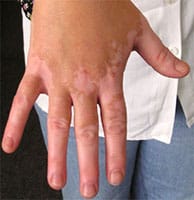So what exactly is this skin phenomenon? Besides having several names (vitiligo disease or just vitiligo; leukoderma or leucoderma), we don’t know as much about it as one would hope.
Since we have some clinical definitions that won’t make sense to most people and yet at the same time we don’t have a real strong understanding of why it occurs, let me start with some examples of some ways vitiligo disease may be misdiagnosed so at least you can understand what vitiligo is not.
You see, not all white skin patches are vitiligo. Several other conditions can be behind those white blotches of skin. Alphos, a form of leprosy was once mislabeled as vitiligo.
Other diseases or conditions that should be ruled out when diagnosing vitiligo disease are Tinea Versicolor, Albinism, Melanism, Leucism, and Pityriasis alba.
So it is important that you carefully and accurately diagnose this condition before you proceed with any treatments. You can obtain an accurate diagnosis with two methods: An Ultraviolet Wood’s Lamp examination and a biopsy.
Under an Ultraviolet Wood’s Lamp, vitiligo disease exhibits a distinct fluorescence absent in the aforementioned skin diseases. In a darkened room, light from a Wood’s lamp reveals vitiligo by the way depigmented skin and pigmented skin reflect this distinct light in different manners. Pigmented skin will absorb the light while depigmented skin will reflect the light.
A biopsy will indicate vitiligo through an absence of melanocytes in the skin sample.
Obviously the ultraviolet light is less invasive and it more consistently provides an accurate and definitive diagnosis.
So what exactly is happening with hypopigmentation (the decreasing pigmentation of the skin)?
Currently, researchers associate vitiligo with inflammatory and autoimmune diseases, most specifically and commonly thyroid underexpression and thyroid overexpression. This can become highly technical, but essentially a change in amino acids occurs at the genetic level.
The gene believed to be misbehaving is the NALP1 gene. When something influences this gene (it could be an innate genetic pattern, an environmental factor or it could be the results of another autoimmune disease in your system), it causes certain inflammation-oriented amino acids to flourish. When an over-abundance of these amino acids occur, they can cause an adverse reaction in the cells they normally regulate.
This theoretically can lead to a decrease in the amino acid tyrosine, which melanocytes use to make melanin. Hypopigmentation, the phenomenon in vitiligo disease which leads to the lighter skin, is caused by melanocyte depletion.
This is also why I believe individuals suffering from vitiligo should be examined for autoimmune diseases. Some studies indicate a relatively high occurrence of vitiligo with these autoimmune diseases, in particular Addison’s disease.
I hope this provides a little more technical information behind the phenomenon without bogging you down in so many technical details your eyes glass over. As some say, sometimes a picture is worth a thousand words, so I’ve included a basic vitiligo picture in this guide.
Thank you for reading my guide. I really hope vitiligo disease sufferers leave my site a little more informed and empowered than they felt when arriving here.

